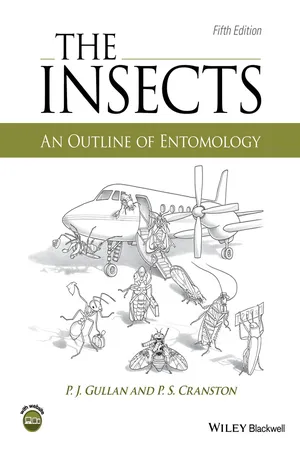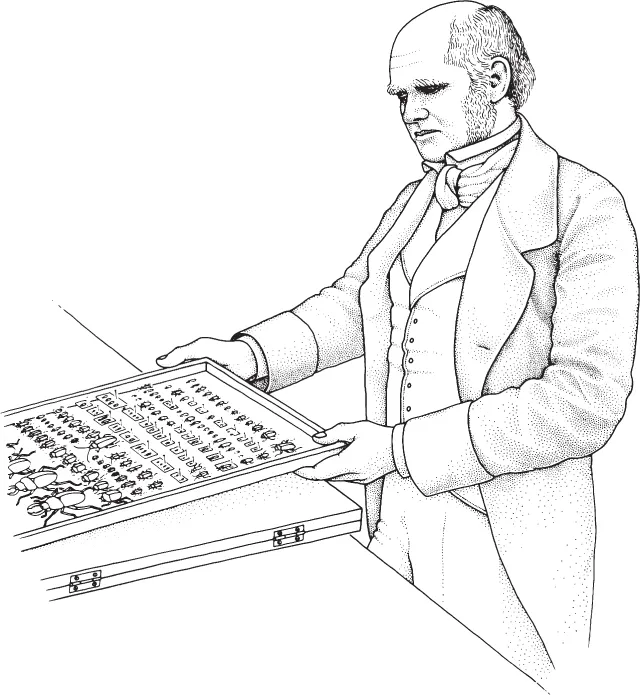
- English
- ePUB (mobile friendly)
- Available on iOS & Android
About this book
Insects represent over half of the planet's biological diversity. This popular textbook provides a comprehensive introduction to this extraordinary diversity, and places entomology central to the theory and practice of evolutionary and ecological studies.
Fully revised, this fifth edition opens with a chapter concerning the popular side of insect studies, including insects in citizen science, zoos and butterfly houses, and insects as food for humans and animals. Key features of insect
structure, function, behaviour, ecology and classification are integrated with appropriate molecular studies. Much of the book is organized around major biological themes: living on the ground, in water, on plants, in colonies, and as predators, parasites/parasitoids and prey insects. A strong evolutionary theme is maintained throughout.
There is major revision to the chapter on systematics and a new chapter, Insects in a Changing World, includes insect responses to, and the consequences of, both climate change and human-assisted global alterations to distributions. Updated 'Taxoboxes' demonstrate topical issues and provide concise information on all aspects of each of the 28 major groupings (orders) of insects, plus the three orders of non-insect hexapods. New boxes describe a worrying increase in insect threats to landscape and commercial trees (including eucalypts, palms and coffee) and explain the value of genetic data, including evolutionary developmental biology and DNA barcoding, in insect biodiversity studies.
The authors maintain the clarity and conciseness of earlier editions, and extend the profuse illustrations with new hand-drawn figures. Over 50 colour photographs, together with the informative text and an accompanying website with links to video clips, appendices, textboxes and further reading lists, encourage a deeper scientific study of insects. The book is intended as the principal text for students studying entomology, as well as a reference text for undergraduate and graduate courses in the fields of ecology, agriculture, fisheries and forestry, palaeontology, zoology, and medical and veterinary science.
Frequently asked questions
- Essential is ideal for learners and professionals who enjoy exploring a wide range of subjects. Access the Essential Library with 800,000+ trusted titles and best-sellers across business, personal growth, and the humanities. Includes unlimited reading time and Standard Read Aloud voice.
- Complete: Perfect for advanced learners and researchers needing full, unrestricted access. Unlock 1.4M+ books across hundreds of subjects, including academic and specialized titles. The Complete Plan also includes advanced features like Premium Read Aloud and Research Assistant.
Please note we cannot support devices running on iOS 13 and Android 7 or earlier. Learn more about using the app.
Information
Chapter 1
The Importance, Diversity and Conservation of Insects

1.1 WHAT IS ENTOMOLOGY?
1.2 The importance of insects

Box 1.1 Citizen entomologists—community participation


Table of contents
- Cover
- Title Page
- Copyright
- List of Colour Plates
- List of Boxes
- Preface to the Fifth Edition
- Preface to the Fourth Edition
- Preface to the Third Edition
- Preface to the Second Edition
- Preface and Acknowledgments for First Edition
- About the Companion Website
- Chapter 1: The Importance, Diversity and Conservation of Insects
- Chapter 2: External Anatomy
- Chapter 3: Internal Anatomy and Physiology
- Chapter 4: Sensory Systems and Behaviour
- Chapter 5: Reproduction
- Chapter 6: Insect Development and Life Histories
- Chapter 7: Insect Systematics: Phylogeny and Classification
- Chapter 8: Insect Evolution and Biogeography
- Chapter 9: Ground-Dwelling Insects
- Chapter 10: Aquatic Insects
- Chapter 11: Insects and Plants
- Chapter 12: Insect Societies
- Chapter 13: Insect Predation and Parasitism
- Chapter 14: Insect Defence
- Chapter 15: Medical and Veterinary Entomology
- Chapter 16: Pest Management
- Chapter 17: Insects in a Changing World
- Chapter 18: Methods in Entomology: Collecting, Preservation, Curation and Identification
- Taxoboxes
- Glossary
- References
- Index
- Appendix: A Reference Guide to Orders
- Supplemental Images
- End User License Agreement